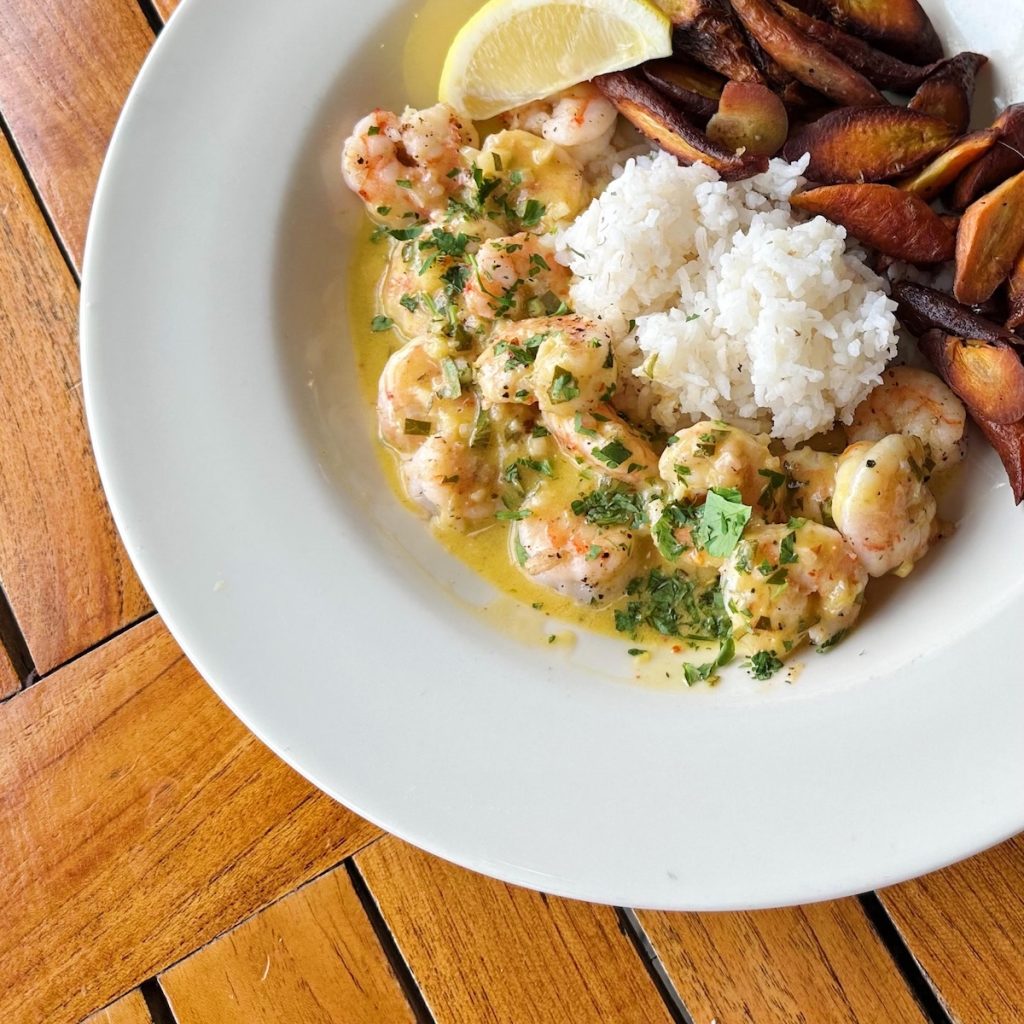Wild-Caught Shrimp Ladolemono at the Roadhouse

A culinary homage to Ann Arbor’s Greek community
In his inaugural address as the president of the University of Michigan (U of M) in 1852, Henry Tappan shared a piece of his vision for the still-young university town: “Here a new Athens shall arise.” Tappan was speaking about the commitment to learning, philosophy, and art that he imagined ancient Athens to have had. He also imagined U of M attaining a level of fame and excellence equal to Europe’s finest institutions of higher learning!
At the time, the enormous university we know today was five years younger than the ZCoB is now. U of M was founded in 1817 in Detroit and had moved to a relatively empty 40-acre plot in Ann Arbor in 1837, right around the same time the house and barn at what we now know as Cornman Farms were being built. At the time, the faculty of Science, Literature, and Arts was only eight professors, and there were all of about 60 students in undergrad programs—not even enough to make a busy lunch rush at the Deli. The university’s first African American student arrived to study medicine in 1853, a year after Tappan gave his speech..
Despite the appeal to Athenize Ann Arbor, Tappan was not, I’m pretty confident, suggesting that the town should become a focal point for Greek immigration. On the day he spoke, not a single one of the 3,000 or so residents of Ann Arbor would likely have been of Greek origin. The first Greek arrivals came nearly half a century later, starting in the late 1890s, not long after Rocco and Katherine Disderide, who built what’s now the Deli’s building in 1902, moved here from northern Italy. Most of the new Greek immigrants were single men who came to find work.
At the time, Greeks in the U.S. were “classed” as “non-white” and were often discriminated against; in the Immigration act of 1924, Greeks were put into the smallest allowable quota category. The Greek population of Ann Arbor stayed relatively small until its first Orthodox priest was brought to town in 1927. In the 1930s, Ann Arbor’s first Greek church, St. Nicholas, was built, and the community grew rapidly from there. Many Greek families at the time anglicized their names to fit in. William and Adriana Skinner ran the Ideal Restaurant in the 1930s on East Washington Street, and the Curtis family ran Chicken in the Rough on Main Street in 1947. The Parthenon on the corner of Main and Liberty, opened by the Gavras brothers, was a classic in town from around the time I came to school here in the ’70s until they sold it in 2012. (My friend John U. Bacon—whose wonderful book about the Edmund Fitzgerald, The Gales of November, came out recently—wrote a lovely homage to the Parthenon.)
All of which is a lead-in to a description of this great dish of wild-caught shrimp that’s on the Roadhouse specials list this month. These amazingly flavorful shrimp are cooked with a traditional Greek lemon olive oil dressing and served with wonderful Carolina Gold rice and roasted organic carrots (the best in the county, in my opinion!) from Tantré Farm. This dish is delicious and, to my taste, most definitely worth driving across town for.
The shrimp, to be clear, are the key. They are so, so, so seriously good! As one guest said the other evening, “These taste totally different from what everyone else gets. This is the only place I order shrimp around here!” We get them from the team at Locals Seafood in North Carolina. The Locals story starts back in the later years of the Aughties, when Ryan was living in the Outer Banks. A year or two later, in 2010, he and his longtime friend Lin started selling wild shrimp that were caught off the coast of Stumpy Point Bay on the north coast of the state. A few years later, they had a fish shop and restaurant in Raleigh and a thriving wholesale business that recently added the Roadhouse as a customer! Of their outstanding work, the Locals crew offers:
We’ve forged strong personal relationships with the folks who catch, harvest, and process the product we sell… these relationships result in a better product for our customers and a shorter supply chain for our seafood. We know where our product came from, when it came out of the ocean, and how it was caught or harvested.
North Carolina shrimp, like what we get from Locals, are renowned for their clean flavor and finish, and these fill the bill. They’re the top choice of many of the country’s best chefs.
The day-to-day, in-restaurant reality of the shrimp market is, unfortunately, not so great. In the New York Times, my friend Melissa Clark wrote, “Domestic, wild-caught shrimp accounts for less than 10 percent of all the shrimp we eat in this country.” Chef Edward Lee says, “Most farmed shrimp from Asia have no detectable flavor, good or bad.” The Locals shrimp are the opposite: 80 percent come from Pamlico Sound and the rest from boats fishing just off the coast, nearly all of which are caught by “day boats” that fish and then return quickly to port to ensure freshness. You really can taste the difference. The flavor is mellow but meaty, clean, and complex, with a beautiful, long finish.
The wild-caught shrimp show up in other spots on the menu, too, but here they’re cooked in a classic Greek sauce of fresh lemon juice, extra virgin olive oil, garlic, shallots, and a bunch of fresh herbs. In the pan, the dish is finished with some of that remarkable Vermont Creamery Cultured Butter I keep talking about! Swing by this month and grab a taste of this super-tasty wild shrimp dish!



